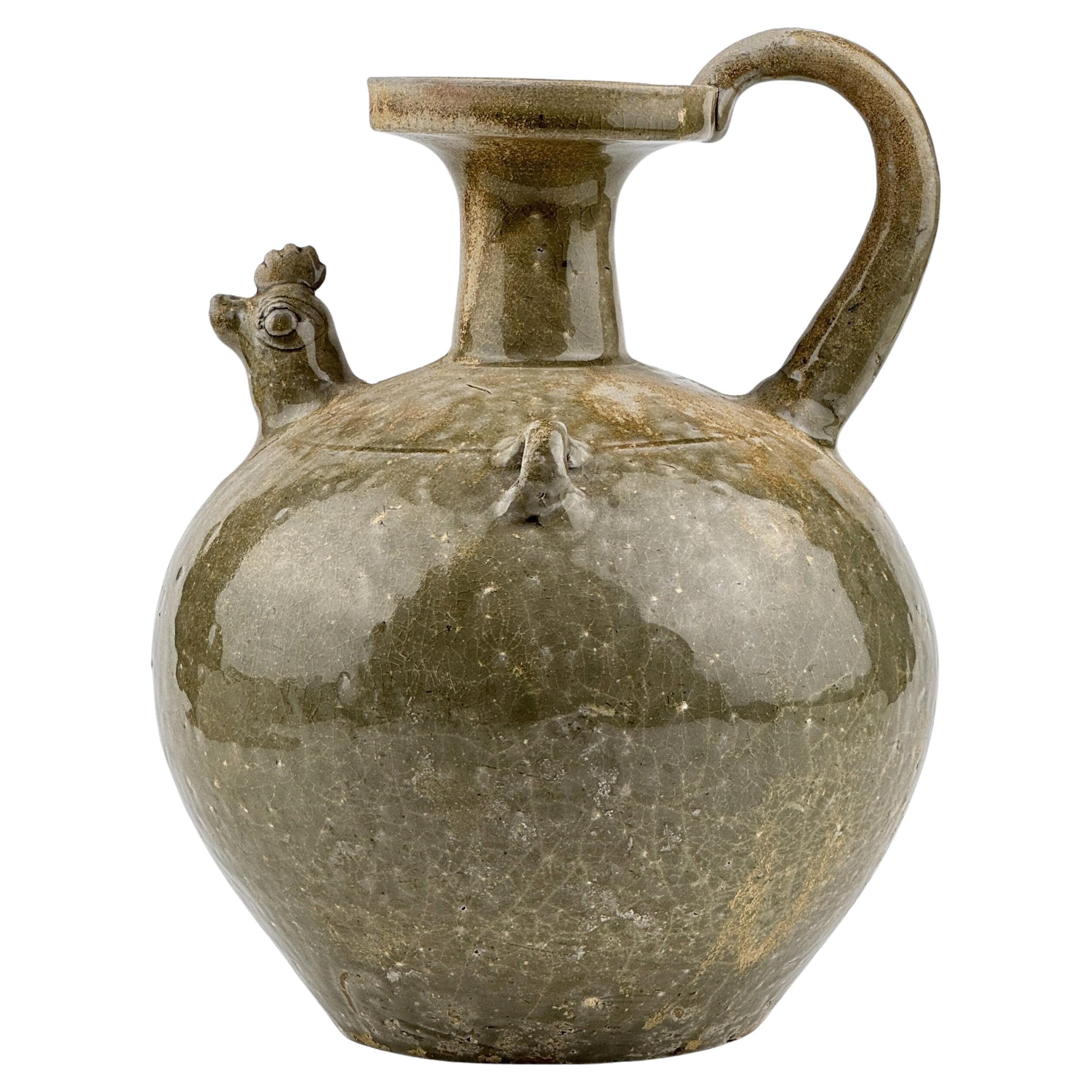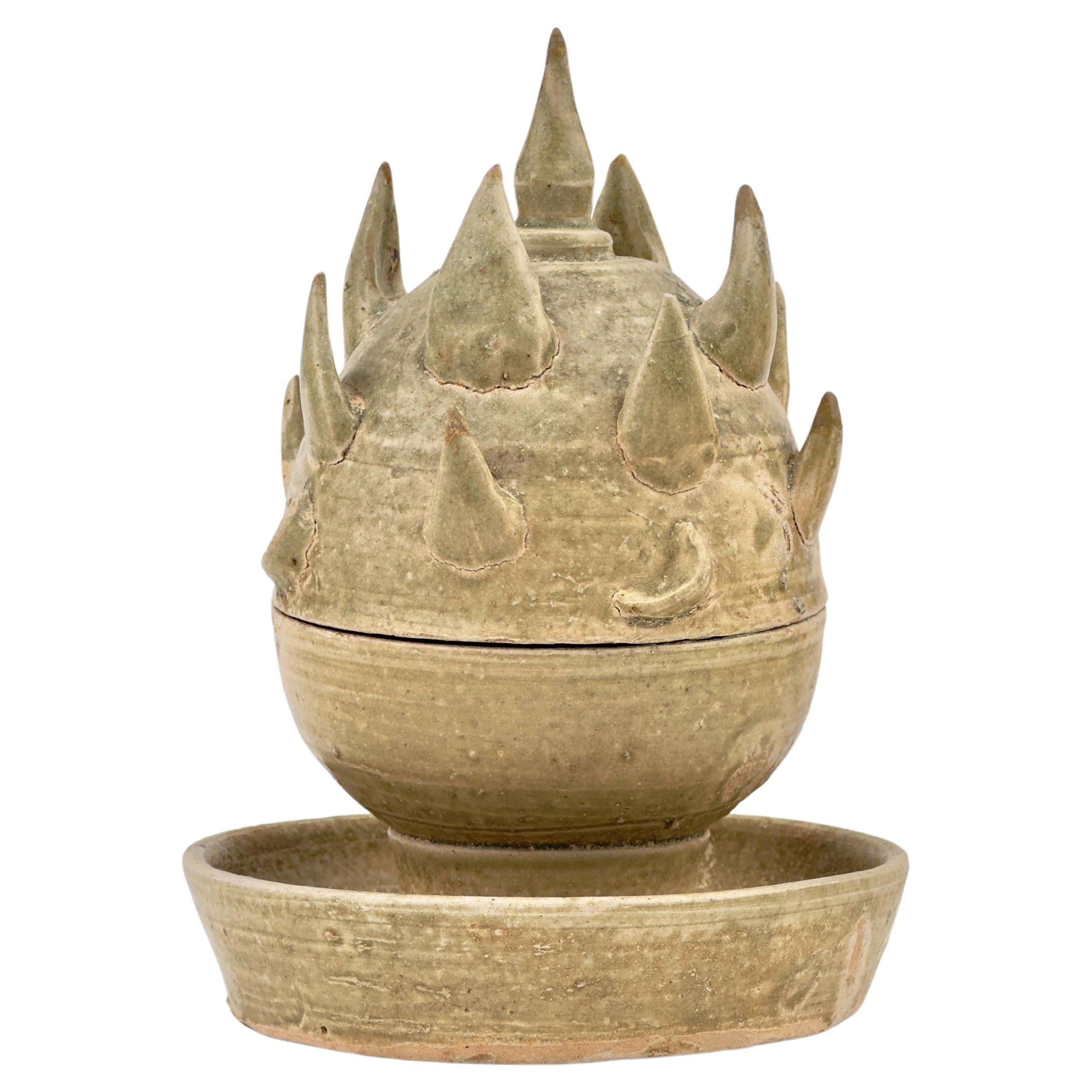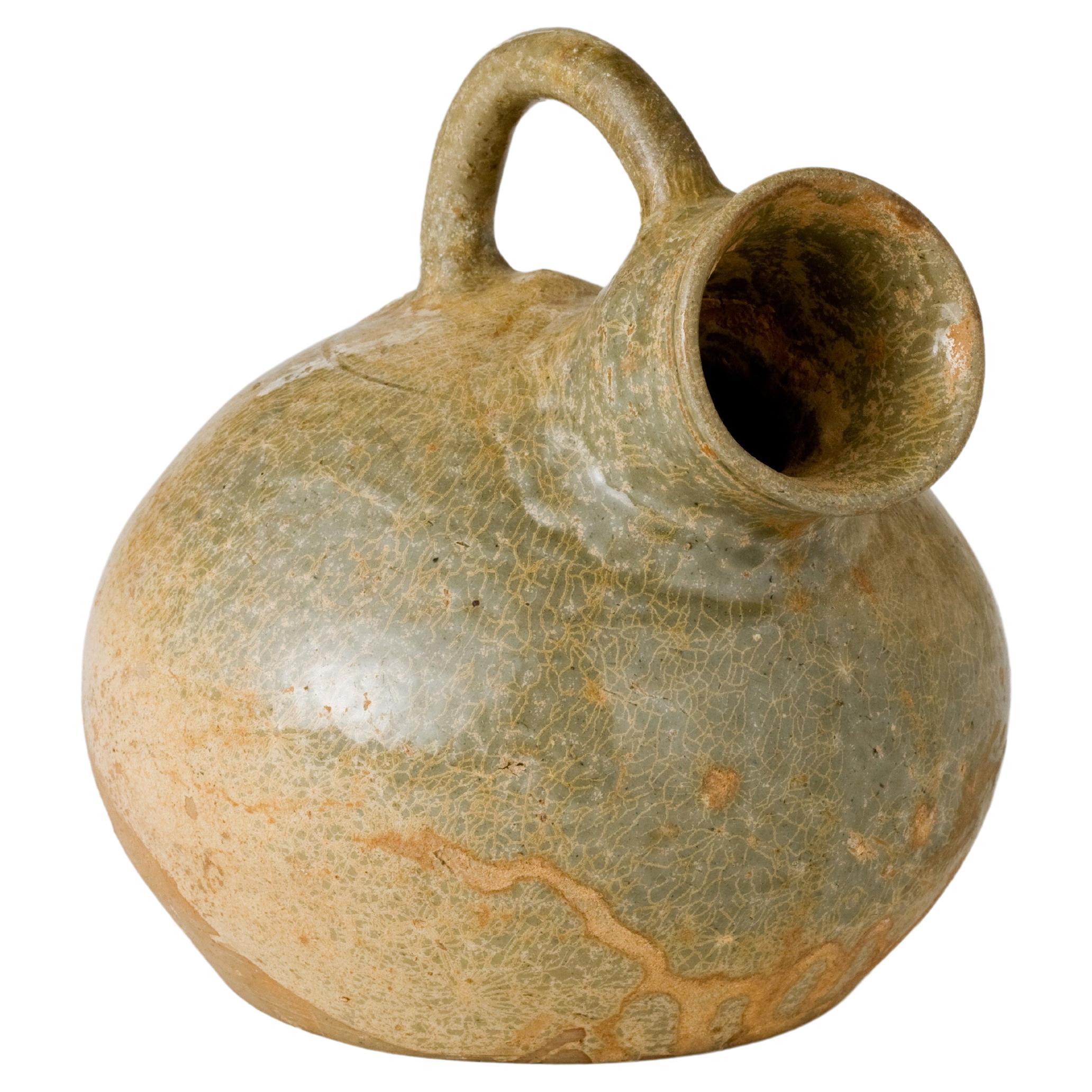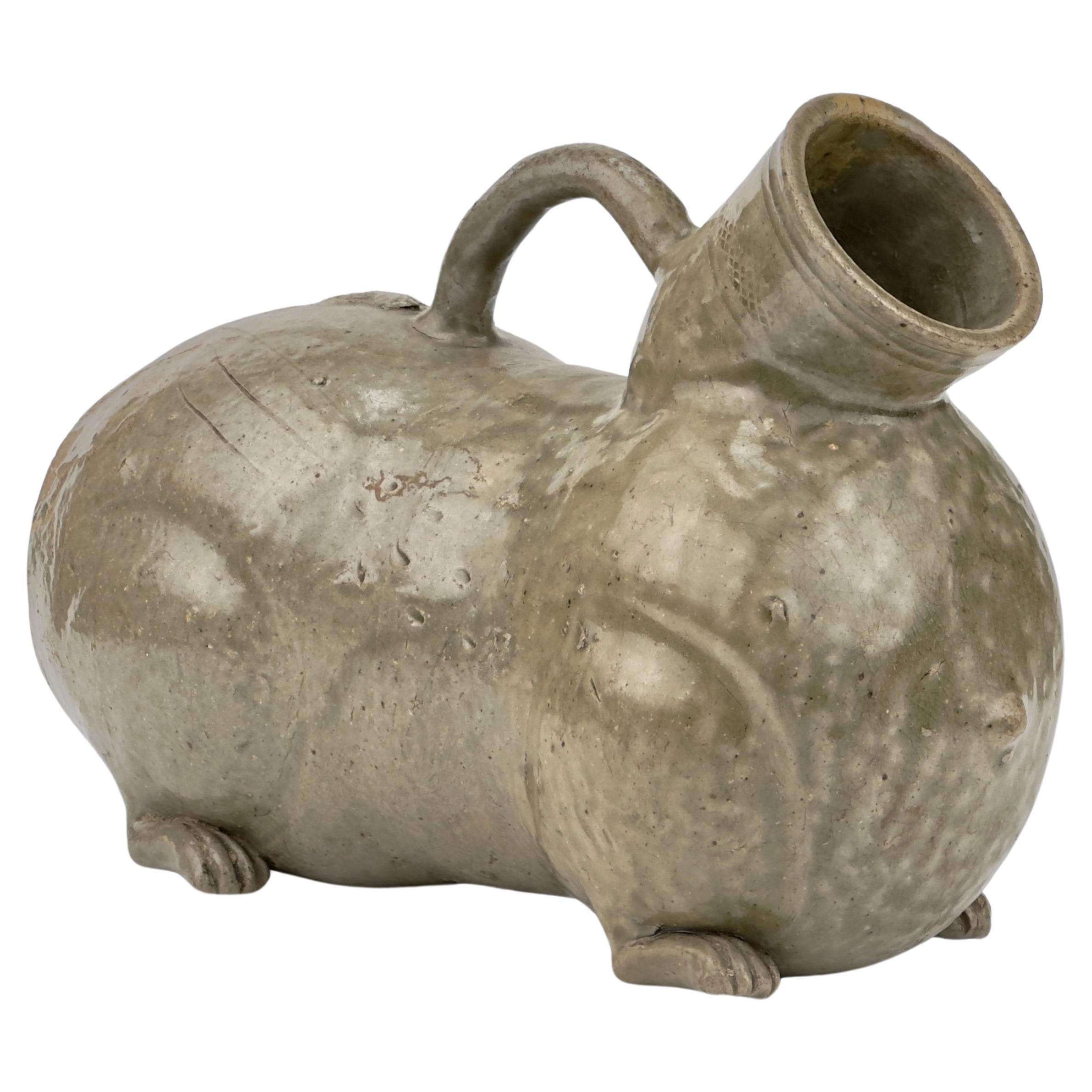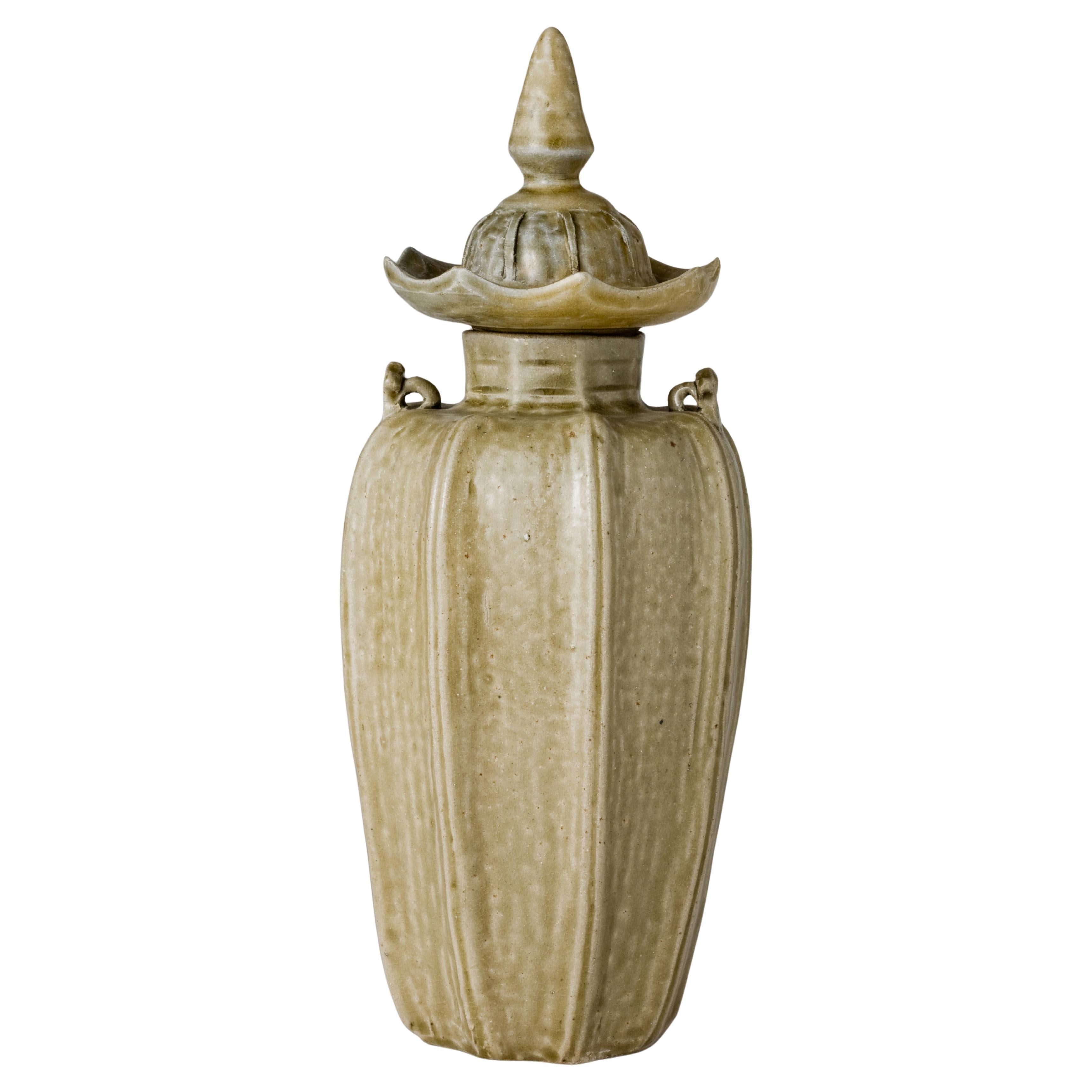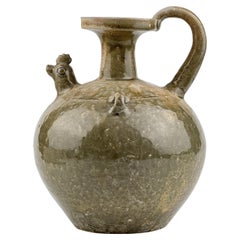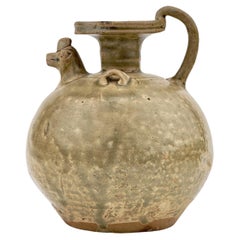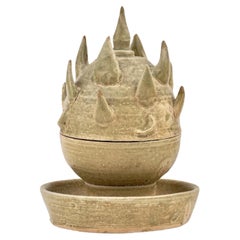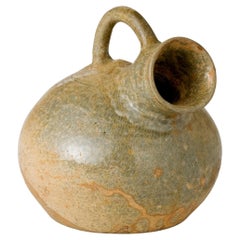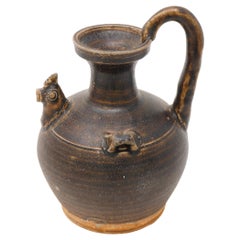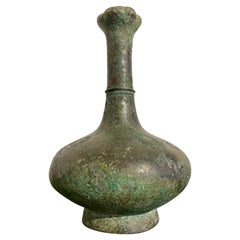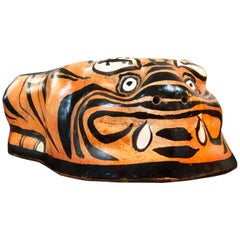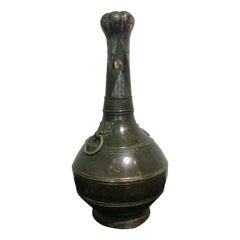Items Similar to Rare Yue Celadon Chicken-Head Ewer, Jin-Southern Dynasty
Want more images or videos?
Request additional images or videos from the seller
1 of 17
Rare Yue Celadon Chicken-Head Ewer, Jin-Southern Dynasty
About the Item
Chicken-head celadon is among the most distinct and emblematic piece from the dynamic yet innovative era spanning from the Han (206 BC - AD 220) to the Tang (618-907) dynasties. Their production commenced during the Jin dynasty (265-420) in the southern Yue kilns of Zhejiang province. The design was quickly spread to other southern factories and eventually embraced by northern celadon kilns.
The widespread application of such ceramic vessels, including in the burial sites of emperors, underscores the fortuitous connotations of the chicken motif. Chickens were considered to possess the capability to dispel evil, heal ailments, and produce other benevolent effects.
The mouth part of this piece has been repaired. There is clear evidence of excavation on the surface on four sides. Other similar pieces have handles, but this piece has been replaced with a tail.
Period : Jin-Southern Dynasty (266 - 589 AD)
Type : Ewer
Medium : Yue celadon(Stoneware)
Provenance : The piece was acquired in Hong Kong in the late 1990s
Reference :
1) Ashmolean Museum - Accession no.EA1956.286
(Type : Closely related)
2) Sotheby's Hongkong 27 November 2020 - CHINA / 5000 YEARS 博古五千 - Lot 384
(Price Range : 260,000HKD-360,000HKD / Type : Closely related)
* Yue Celadon
Yue celadon, also known as Yue ware, is a type of Chinese pottery with a celadon glaze, originating from the eastern Han dynasty (25~220 AD) in the Zhejiang province. The name 'Yue' comes from the Yue kilns which were among the earliest to develop the celadon technique. Yue ware is known for its jade-like glaze, which can range in color from bluish-green to olive green.
Yue celadon was highly regarded during its time and was the first Chinese ware to be imported in large quantities to the Middle East and Africa, significantly influencing the development of ceramics in those regions. The production of Yue ware continued to evolve, and during the Tang dynasty (618-907 AD), it became more refined with more complex shapes and decorations. By the time of the Song dynasty (960~1279 AD), it had greatly influenced other kiln traditions, leading to the development of the classic longquan celadon, which became one of China’s most famous ceramic products.
Yue celadon traditionally embodies elements of auspiciousness and good fortune in Chinese culture. The jade-like celadon glaze is often associated with longevity and health. Various motifs and shapes inscribed on the pottery frequently symbolize luck and prosperity. For example, lotus patterns may represent purity and immortality, while animal figures like the lion symbolizes power, courage, and strength. Lions are considered protectors that ward off evil spirits and bring forth good luck. Furthermore, Yue celadon wares were commonly used as tomb offerings in ancient China, believed to bring fortune and well-being to the deceased in the afterlife.
- Dimensions:Height: 6.7 in (17 cm)Diameter: 4.34 in (11 cm)
- Style:Han (Of the Period)
- Materials and Techniques:Celadon,Glazed
- Place of Origin:
- Period:
- Date of Manufacture:266 - 589 AD
- Condition:Repaired: Mouth was repaired. Minor fading.
- Seller Location:seoul, KR
- Reference Number:1stDibs: LU9577239609212
About the Seller
4.8
Gold Seller
Premium sellers maintaining a 4.3+ rating and 24-hour response times
Established in 1999
1stDibs seller since 2023
35 sales on 1stDibs
Typical response time: 1 hour
- ShippingRetrieving quote...Shipping from: seoul, Korea South
- Return Policy
Authenticity Guarantee
In the unlikely event there’s an issue with an item’s authenticity, contact us within 1 year for a full refund. DetailsMoney-Back Guarantee
If your item is not as described, is damaged in transit, or does not arrive, contact us within 7 days for a full refund. Details24-Hour Cancellation
You have a 24-hour grace period in which to reconsider your purchase, with no questions asked.Vetted Professional Sellers
Our world-class sellers must adhere to strict standards for service and quality, maintaining the integrity of our listings.Price-Match Guarantee
If you find that a seller listed the same item for a lower price elsewhere, we’ll match it.Trusted Global Delivery
Our best-in-class carrier network provides specialized shipping options worldwide, including custom delivery.More From This Seller
View AllRare Yue Celadon Chicken-Head Ewer, Jin-Southern Dynasty
Located in seoul, KR
Chicken-head ewers are among the most distinct and emblematic pottery pieces from the Han (206 BC ~ AD 220) to the Tang dynasties. Their production commenced during the Jin dynasty i...
Category
Antique 15th Century and Earlier Hong Kong Han Antiquities
Materials
Pottery
$6,000 Sale Price
56% Off
Rare Yue Celadon Chicken-Head Ewer, Jin-Southern Dynasty
Located in seoul, KR
Chicken-head ewers are among the most distinct and emblematic pottery pieces from the Han (206 BC - AD 220) to the Tang (618-907) dynasties. Their production commenced during the Jin...
Category
Antique 15th Century and Earlier Hong Kong Han Antiquities
Materials
Celadon, Stoneware
$7,160 Sale Price
60% Off
Rare Boshan Incense Burner Yue Celadon, Jin dynasty
Located in seoul, KR
The Boshan incense burner is particularly notable among Han dynasty incense burners for its unique shape. Designed to resemble a mountain or even a mythical mountain, it is characterized by its pointed peaks that rise upwards. These peaks often function as vents for the smoke, creating an effect reminiscent of a volcanic eruption.
The body of the incense burner is typically round, with multiple small peaks surrounding a central, larger peak. The material used is mainly ceramic, although there are instances where they were made of bronze. It is presumed that this incense burner was used for religious or ceremonial purposes during its time. The colors of these burners are usually in shades of pale green or greyish brown, with the application of glaze to achieve a variety of colors on occasion.
Such incense burners are often found in tombs or ritual sites, and their purpose was to burn incense for purification of space or to produce pleasant aromas. The Boshan incense burner also represents a significant cultural heritage, showcasing the craftsmanship and artistic values of the period. Today, it is considered a quintessential example of ancient Chinese art.
Period : Han-Jin Dynasty
Type : Incense Burner
Medium : Yue celadon...
Category
Antique 15th Century and Earlier Hong Kong Han Antiquities
Materials
Stoneware
$5,960 Sale Price
60% Off
Rare Yue Celadon-Glazed Vessel, Jin dynasty (265-420)
Located in seoul, KR
A Yue celadon vessel from the Jin Dynasty period, notable for its characteristic greenish-glazed pottery which was prominent during this time. The vessel features a globular body wit...
Category
Antique 15th Century and Earlier Hong Kong Han Antiquities
Materials
Stoneware
$2,535 Sale Price
35% Off
Rare Yue Celadon-Glazed Figural Vessel, Western Jin dynasty (265-420)
Located in seoul, KR
This vessel is well-modeled as a recumbent winged lion with detailed decorative elements. It features a grimacing face with large protruberant eyes under heavy brows and a gaping mou...
Category
Antique 15th Century and Earlier Hong Kong Han Antiquities
Materials
Celadon
$6,360 Sale Price
60% Off
A Rare 'Yue' Celadon Glazed Octagonal Vase, Western Jin Dynasty (266 - 316 AD)
Located in seoul, KR
Finely potted with incurved facetted sides divided by raised ribs and set with two short lugs to the shoulder, the body rising to a short octagonal neck, the domed cover of conforming section, surrounded by an upturned rim and surmounted by a bud finial, applied overall with a celadon glaze of the period.
A related vase of this rare and charming form, in the Zhenjiang Museum, Zhenjiang, is illustrated in the Complete Collection of Chinese Ceramics. Song, vol. 8, Shanghai, 1999, pl. 52. Vases of related octagonal shape were produced at the Ding kilns, in Hebei province, and the qingbai kilns in Jiangxi province; see a Ding vase in the Palace Museum, Beijing, illustrated in Selection of Ding Ware. The Palace Museum’s Collection and Archaeological Excavation, Beijing, 2002, pl. 37; and a qingbai example, from the Meiyintang collection, illustrated in Regina Krahl, Chinese Ceramics from the Meiyintang Collection, vol. 3 (II), London, 2006, pl. 1590; and another carved with a floral scroll, included in the exhibition Song Ceramics from the Kwan Collection, Hong Kong Museum of Art, Hong Kong, 1994, cat. no. 105.
Period : Western Jin Dynasty (266 - 316 AD)
Type : Octagonal Vase
Medium : Yue celadon...
Category
Antique 15th Century and Earlier Hong Kong Han Antiquities
Materials
Celadon
$19,975 Sale Price
75% Off
You May Also Like
Antique Chinese Yue Chicken Head Spout Ewer
Located in Point Richmond, CA
A globular stoneware body that is well potted with a cup shaped mouth supported on a narrow tall neck. The characteristic chicken head form serves as the spout. The handle is pulled ...
Category
Antique 15th Century and Earlier Chinese Other Ceramics
Materials
Ceramic
Chinese Western Han Dynasty Bronze Garlic Head Vase, 206 BC - 25 AD
Located in Austin, TX
A rare and attractive Chinese bronze "garlic head" vase with an encrusted patina, Western Han Dynasty, 206 BC - 25 AD, China.
Of classic form, the bronze vase is set on a short, s...
Category
Antique 15th Century and Earlier Chinese Han Antiquities
Materials
Bronze
Jin Dynasty Cizhou Ware Crouching Tiger Pottery Pillow, 12th-century, China
Located in Brooklyn, NY
Chinese Jin Dynasty 12th Century Cizhou Ware Crouching Tiger Pottery Pillow .Tiger pillow, Jin dynasty, 12th century (circa 1150)
The pillow is assembled ...
Category
Antique 15th Century and Earlier Chinese Ming Antiquities
Materials
Ceramic
Chinese Han Dynasty Silver-Decorated Garlic Head Bronze Hu Vase, 3rd Century BC
Located in Austin, TX
A gorgeous and striking late Warring States (475 to 221 BC) or early Han Dynasty (221 to 206 BC) cast bronze and silver-decorated garlic head hu vessel.
Of elegant bottle form, w...
Category
Antique 15th Century and Earlier Chinese Han Antiquities
Materials
Bronze
China 100 BC Han Dynasty Ancient Rare Stickman Sculpture in Earthenware Pottery
Located in Miami, FL
Standing Stickman from the Han Dynasty.
Original ancient Chinese tomb attendants sculpture of a tall, thin standing man wearing a short tunic. Beautifully crafted in grey earthenw...
Category
Antique 15th Century and Earlier Chinese Han Antiquities
Materials
Iron
Rare Large Antique Celadon Bowl or Jardinière
Located in Alessandria, Piemonte
Antique perfect Celadon bowl : interesting for connoisseurs. It's from 18th century and it's perfect.
It was in a private Italian collection, now may be on You table because I'm clo...
Category
Antique 18th Century Chinese Chinese Export Antiquities
Materials
Porcelain
Recently Viewed
View AllMore Ways To Browse
Antique Well Head
Antique Southern Furniture
Southern Chinese
Asian Heads
Early Southern Furniture
Antique China Head
Green Celadon
Large Ceramic Head
Celadon Glazed
Antique Chicken
Chinese Song Dynasty
Song Dynasty Furniture
Large Celadon
Antique Chinese Celadon
Chinese Celadon Glazed
Chinese Celadon Ceramics
Chinese Ceramic Figures
Song Dynasty Ceramics
